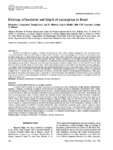Please use this identifier to cite or link to this item:
http://www.alice.cnptia.embrapa.br/alice/handle/doc/510894| Title: | Etiology of bacterial leaf blight of eucalyptus in Brazil. |
| Authors: | GONCALVES, R. C.  LAU, D.   OLIVEIRA, J. R.   MAFFIA, L. A.   CASCARDO, J. C. M.   ALFENAS, A. C.   |
| Affiliation: | RIVADALVE COELHO GONCALVES, CPAF-AC; DOUGLAS LAU, CNPT; José R. Oliveira, Universidade Federal de Viçosa (UFV); Luiz A. Maffia, Universidade Federal de Viçosa (UFV); Júlio C. M. Cascardo, Universidade Estadual de Santa Cruz (UESC); Acelino C. Alfenas, Universidade Federal de Viçosa (UFV). |
| Date Issued: | 2008 |
| Citation: | Tropical Plant Pathology, Brasília, DF, v. 33, n. 3, p. 180-188, May/Jun. 2008. |
| Description: | Bacterial leaf blight of eucalyptus is initially characterized by water soaked, angular, amphigenous and interveinal lesions, concentrated along the main vein, at the edges or scattered on the leaf blade. As the disease progresses, the lesions become brown to pale, and when young leaves are infected leaf cut areas at the edges or perforations at the center of the lesions may appear due to abortion of the necrotic area. Eventually, necrosis may be found on petiole and twigs. Leaf fall commonly occurs on highly susceptible genotypes due to the early senescence of diseased leaves. Precise diagnosis is accomplished by bacterial exudation from leaf sections placed in a water drop under light microscope (200 x). Twenty-five bacterial isolates from Amapá (2), Bahia (4), Minas Gerais (2), São Paulo (9), Pará (3), Mato Grosso do Sul (1), and Rio Grande do Sul (4) States, which induced hypersensitive reaction (HR) in non-host plants and were pathogenic to eucalyptus, when inoculated by inoculum injection, were identified by biochemical assays, using carbon sources (MicroLogTM BIOLOG) and sequence analysis (16S rDNA). Ten isolates were identified as Xanthomonas axonopodis, four as X. campestris, four as Pseudomonas syringae, two as P. putida, two as P. cichorii, one as Erwinia sp., and two were similar to bacterial genera of Rhizobiaceae. When spray inoculated on intact plants of eucalyptus, only X. axonopodis, P. cichorii and isolates of the Rhizobiaceae family induced typical symptoms of the disease and were considered pathogenic. In Brazil, X. axonopodis seems to be the most widespread species causing the bacterial leaf blight of Eucalyptus spp. |
| Thesagro: | Doença de planta Bactéria Mancha foliar Etiologia Eucalipto Eucalyptus spp |
| NAL Thesaurus: | Plant diseases and disorders Leaf blight Etiology Erwinia Pseudomonas Xanthomonas Rhizobiaceae |
| Keywords: | Enfermedades y desórdenes de las plantas Marchitez foliar |
| ISSN: | 1983-2052 (online) |
| DOI: | 10.1590/S1982-56762008000300002. |
| Type of Material: | Artigo de periódico |
| Access: | openAccess |
| Appears in Collections: | Artigo em periódico indexado (CPAF-AC)  |










